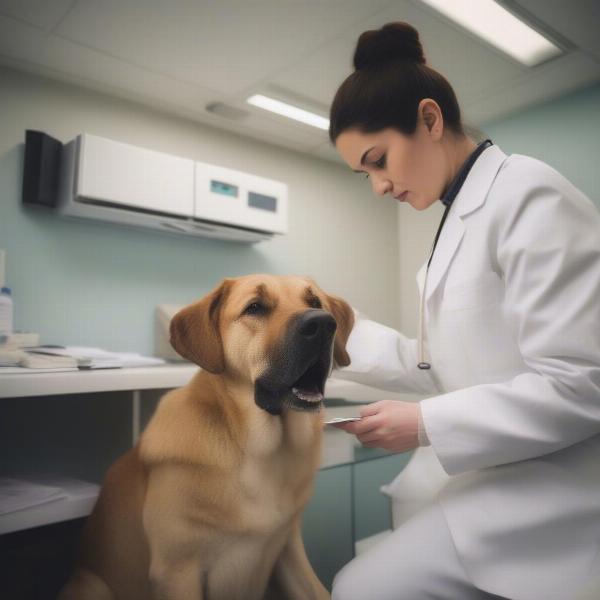Basophils are a type of white blood cell that plays a crucial role in your dog’s immune system. While less common than other white blood cells like neutrophils and lymphocytes, basophils are vital for defending against parasites and allergic reactions. Understanding their function and what elevated or lowered basophil levels can indicate is important for ensuring your dog’s health. This article will delve into the world of basophils in dogs, covering everything from their normal function to what abnormal levels might signify.
Basophils are part of the granulocyte family of white blood cells, characterized by the presence of granules within their cytoplasm. These granules contain histamine and heparin, which are released when the basophil encounters an allergen or parasite. Histamine contributes to the inflammatory response, causing symptoms like itching, swelling, and redness. Heparin acts as a blood thinner, preventing clotting at the site of inflammation. This complex interplay of substances allows basophils to be effective defenders against threats.
What is the Normal Basophil Count in Dogs?
A normal basophil count in dogs typically ranges from 0 to 300 cells per microliter of blood. However, slight variations can occur depending on the individual dog, age, and the specific laboratory conducting the test. It’s important to remember that a single blood test isn’t always definitive, and your veterinarian will consider other factors and potentially repeat the test to confirm any findings.
Causes of High Basophils in Dogs (Basophilia)
High levels of basophils, known as basophilia, can indicate several underlying conditions. One of the most common reasons for basophilia is parasitic infections, such as heartworm or intestinal parasites. Allergic reactions, whether to food, environmental allergens, or insect bites, can also trigger increased basophil production. Certain types of cancer, like mast cell tumors, can also lead to elevated basophil levels.
Recognizing Symptoms Associated with Basophilia
While basophilia itself doesn’t have specific symptoms, the underlying cause will likely manifest in various ways. For example, a dog with a parasitic infection might exhibit diarrhea, vomiting, or weight loss. In the case of allergies, you might notice excessive itching, skin redness, or sneezing.
Causes of Low Basophils in Dogs (Basopenia)
Low levels of basophils, or basopenia, are less common than basophilia. This condition can sometimes occur during periods of acute stress or as a side effect of certain medications, particularly corticosteroids. In some cases, severe infections can temporarily deplete basophil counts. It’s important to note that basopenia often has no noticeable symptoms and is typically discovered during routine blood work.
Understanding the Significance of Low Basophil Counts
While generally less concerning than high basophil counts, basopenia can still provide valuable diagnostic information. It’s essential to discuss any abnormal blood test results with your veterinarian to determine the underlying cause and appropriate course of action.
 Veterinarian Examining Dog Blood Test Results
Veterinarian Examining Dog Blood Test Results
When to Seek Veterinary Attention
If your dog exhibits any signs of illness, such as lethargy, loss of appetite, or changes in behavior, it’s crucial to consult your veterinarian. While these symptoms might not be directly related to basophil levels, they can indicate a range of health issues requiring professional attention. Your veterinarian can perform a complete blood count (CBC), which includes assessing basophil levels, to help diagnose the problem.
Conclusion
Basophils are essential components of your dog’s immune system, playing a vital role in defending against parasites and allergens. While normal basophil levels can vary, significant deviations from the typical range can signal underlying health issues. Regular veterinary checkups and blood work are essential for monitoring your dog’s overall health and detecting any potential problems early. If you notice any changes in your dog’s behavior or health, don’t hesitate to contact your veterinarian for guidance.
FAQ
- What are basophils? Basophils are a type of white blood cell involved in your dog’s immune response, particularly against parasites and allergens.
- What is a normal basophil count in dogs? A normal range is typically 0 to 300 cells per microliter of blood.
- What causes high basophils in dogs? High basophils can be caused by parasitic infections, allergies, or certain cancers.
- What causes low basophils in dogs? Low basophils can be a result of stress, medication side effects, or severe infections.
- What are the symptoms of abnormal basophil levels? There are usually no direct symptoms of abnormal basophil levels, but symptoms related to the underlying cause will likely be present.
- When should I contact my veterinarian about my dog’s basophil levels? Consult your veterinarian if your dog shows any signs of illness or if you have concerns about their blood test results.
- How are abnormal basophil levels treated? Treatment focuses on addressing the underlying cause, whether it’s a parasitic infection, allergy, or another condition.
ILM Dog is a leading international online resource dedicated to providing expert advice and practical information on all aspects of dog care and wellbeing. From breed selection and puppy care to senior dog health and training tips, we strive to empower dog owners worldwide with the knowledge they need to provide the best possible care for their canine companions. We offer comprehensive guides on dog health, nutrition, behavior, and much more. Looking for personalized advice? Contact us at [email protected] or call +44 20-3965-8624. ILM Dog – Your trusted partner in dog care.